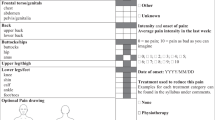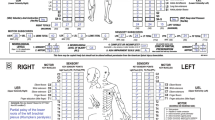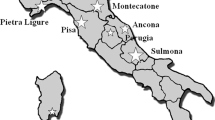Abstract
Study design:
Discussion of issues and development of consensus.
Objective:
Present the background, purpose, development process, format and definitions of the International Spinal Cord Injury Pain (ISCIP) Classification.
Methods:
An international group of spinal cord injury (SCI) and pain experts deliberated over 2 days, and then via e-mail communication developed a consensus classification of pain after SCI. The classification was reviewed by members of several professional organizations and their feedback was incorporated. The classification then underwent validation by an international group of clinicians with minimal exposure to the classification, using case study vignettes. Based upon the results of this study, further revisions were made to the ISCIP Classification.
Results:
An overall structure and terminology has been developed and partially validated as a merger of and improvement on previously published SCI pain classifications, combined with basic definitions proposed by the International Association for the Study of Pain and pain characteristics described in published empiric studies of pain. The classification is designed to be comprehensive and to include pains that are directly related to the SCI pathology as well as pains that are common after SCI but are not necessarily mechanistically related to the SCI itself.
Conclusions:
The format and definitions presented should help experienced and non-experienced clinicians as well as clinical researchers classify pain after SCI.
Similar content being viewed by others
Log in or create a free account to read this content
Gain free access to this article, as well as selected content from this journal and more on nature.com
or
References
Loeser JD, Treede RD . The Kyoto protocol of IASP basic pain terminology. Pain 2008; 137: 473–477.
Hicken BL, Putzke JD, Richards JS . Classification of pain following spinal cord injury: literature review and future directions. In: Burchiel KJ, Yezierski RP, (eds). Spinal Cord Injury Pain: Assessment, Mechanisms, Management. International Association for the Study of Pain Press: Seattle, 2002; vol. 23: 25–38.
Finnerup NB, Faaborg P, Krogh K, Jensen TS . Abdominal pain in long-term spinal cord injury. Spinal Cord 2008; 46: 198–203.
Siddall PJ, McClelland JM, Rutkowski SB, Cousins MJ . A longitudinal study of the prevalence and characteristics of pain in the first 5 years following spinal cord injury. Pain 2003; 103: 249–257.
Cardenas DD, Turner JA, Warms CA, Marshall HM . Classification of chronic pain associated with spinal cord injuries. Arch Phys Med Rehabil 2002; 83: 1708–1714.
Siddall PJ, Taylor DA, McClelland JM, Rutkowski SB, Cousins MJ . Pain report and the relationship of pain to physical factors in the first 6 months following spinal cord injury. Pain 1999; 81: 187–197.
Woolsey RM . Chronic pain following spinal cord injury. J Am Paraplegia Soc 1986; 9: 39–41.
Dijkers M, Bryce T, Zanca J . Prevalence of chronic pain after traumatic spinal cord injury: a systematic review. J Rehabil Res Dev 2009; 46: 13–29.
Bryce TN, Ragnarsson KT . Epidemiology and classification of pain after spinal cord injury. Top Spinal Cord Inj Rehabil 2001; 7: 1–17.
Stormer S, Gerner HJ, Gruninger W, Metzmacher K, Föllinger S, Wienke C et al. Chronic pain/dysaesthesiae in spinal cord injury patients: results of a multicentre study. Spinal Cord 1997; 35: 446–455.
Kaplan LI, Grynbaum BB, Lloyd KE, Rusk HA . Pain and spasticity in patients with spinal cord dysfunction. Results of a follow-up study. JAMA 1962; 182: 918–925.
Burke DC . Pain in paraplegia. Paraplegia 1973; 10: 297–313.
Maury M . About pain and its treatment in paraplegics. Paraplegia 1978; 15: 349–352.
Donovan WH, Dimitrijevic MR, Dahm L, Dimitrijevic M . Neurophysiological approaches to chronic pain following spinal cord injury. Paraplegia 1982; 20: 135–146.
Riddoch G . The clinical features of central pain. Lancet 1938; 234: 1150–1156.
Siddall PJ, Yezierski RP, Loeser JD . Pain following spinal cord injury: clinical features, prevalence, and taxonomy. IASP Newsletter 2000; 3: 3–7.
Bryce TN, Biering-Sorensen F, Finnerup NB et al. International spinal cord injury pain (ISCIP) classification: Part 2. initial validation using vignettes. Spinal Cord, (submitted).
Jensen TS, Baron R, Haanpaa M, Kalso E, Loeser JD, Rice AS et al. A new definition of neuropathic pain. Pain 2011; 152: 2204–2205.
Marino RJ, Barros T, Biering-Sorensen F, Burns SP, Donovan WH, Graves DE et al. International standards for neurological classification of spinal cord injury. J Spinal Cord Med 2003; 26 (Suppl 1): S50–S56.
Attal N, Fermanian C, Fermanian J, Lanteri-Minet M, Alchaar H, Bouhassira D . Neuropathic pain: are there distinct subtypes depending on the aetiology or anatomical lesion? Pain 2008; 138: 343–353.
Putzke JD, Richards JS, Hicken BL, Ness TJ, Kezar L, DeVivo M . Pain classification following spinal cord injury: the utility of verbal descriptors. Spinal Cord 2002; 40: 118–127.
Defrin R, Ohry A, Blumen N, Urca G . Characterization of chronic pain and somatosensory function in spinal cord injury subjects. Pain 2001; 89: 253–263.
Costigan M, Scholz J, Woolf CJ . Neuropathic pain: a maladaptive response of the nervous system to damage. Annu Rev Neurosci 2009; 32: 1–32.
Widerstrom-Noga E, Biering-Sorensen F, Bryce T, Cardenas DD, Finnerup NB, Jensen MP et al. The international spinal cord injury pain basic data set. Spinal Cord 2008; 46: 818–823.
Merskey H, Bogduk N . Classification of chronic pain. In: Merskey H, Bogduk N, (eds). Part III: Pain Terms, a Current List with Definitions and Notes on Usage. IASP Task Force on Taxonomy. IASP Press: Seattle, 1994, 209–214.
Author information
Authors and Affiliations
Corresponding author
Ethics declarations
Competing interests
The authors declare no conflict of interest.
Additional information
Development of the International Spinal Cord Injury Pain Classification was made possible by a grant from the Paralyzed Veterans of America, Washington DC to Mount Sinai School of Medicine.
Rights and permissions
About this article
Cite this article
Bryce, T., Biering-Sørensen, F., Finnerup, N. et al. International Spinal Cord Injury Pain Classification: part I. Background and description. Spinal Cord 50, 413–417 (2012). https://doi.org/10.1038/sc.2011.156
Received:
Revised:
Accepted:
Published:
Issue date:
DOI: https://doi.org/10.1038/sc.2011.156
Keywords
This article is cited by
-
Combined rehabilitation therapy with botulinum toxin to the upper limbs for acute spinal cord injury: A case report
Spinal Cord Series and Cases (2024)
-
The international spinal cord injury pain basic data set (version 3.0)
Spinal Cord (2023)
-
Neuropathic Pain and Spinal Cord Injury: Management, Phenotypes, and Biomarkers
Drugs (2023)
-
Efficacy of transcutaneous electrical nerve stimulation in people with pain after spinal cord injury: a meta-analysis
Spinal Cord (2022)
-
Cross-cultural adaptation and validation of the French version of the Spinal Cord Injury Pain Instrument (SCIPI)
Spinal Cord (2022)



